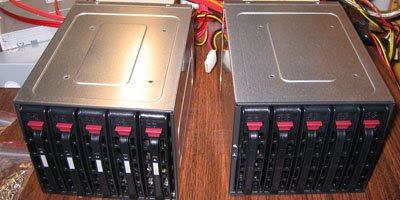
By Jon:
Backups. The digital age has never been more redundant than on that particular subject. Our computing lifestyles are so heavily reliant on our data, and as such I'm more than a little paranoid about it.
This walkthrough explains my home computing setup, which is altogether separate from my corporate life. At work, everything we use is archived and saved on our network, meaning none of my data actually resides on my local hard drive. With my personal life and side-work, I have to be more cautious.
With my new MacBook purchase, I'm more nervous than ever about leaving my data floating on one highly portable machine. At the same time, all my backup devices and methods are fallible and I just plain don't trust them. I have multiple copies of important items and lots of automation has helped me cut back on time spent getting everything synced. Let me run down what I use and how I do it.
Backing Up
I have 2 Firewire hard drives, a stack of DVDs, an online archive, and two thumb drives, all of which are setup solely to house important and needed data -- just in case.
I have a work drive where my current projects reside. Once finished with those projects, I burn a DVD (labeled and catalogued via Excel, of course) and move the project to a NAS network drive. Once I know I don't need the data anymore, I wipe it from the NAS drive but always keep that DVD back up just in case. This lets me shift responsibility off me and onto someone else involved in the project, but have the NAS and DVD just in case there's a problem in the near or distant future.
DVDs aren't perfect though, and can go bad over time -- that's why it's important to ensure someone else is dealing with the archival before wiping the NAS drive.
Automation
That's it for project data. For personal data and my documents, I use thumb drives and a lovely little site called Mozy. Mozy allows 2gb of free storage online, and even allows you to schedule backups nightly.
Using Energy Saver in System Preferences, I'm able to wake my computer at 2:45am each night and run the Mozy backup. This is great because my Mac also likes to run system processes and the like during the night, so it's awake for that as well.
I also keep two thumb drives on hand (one permanently installed in a USB hub and one portable) which I backup to every night. I made my own app via Automator to select my Documents folder and copy onto each drive, ensuring the data exists in multiple locations.
I found a neat little iCal trick to automate the Backup app I created. An iCal event can fire an "alarm," intended to remind you about an upcoming calendar event. This alarm can be a sound, dock bounce, or -- the key -- opening a file. I set my iCal to run the Backup app at 3am every morning (during my Energy Saver window). This works perfectly and ensures that my thumb drives always have up-to-date data on them.
Time Machine
With the MacBook's new Leopard OS, I'm able to use the Time Machine functionality. As I mentioned, I have an NAS Networked external hard drive, which allows wireless connectivity to the drive anywhere in my home network. I use this drive as my Time Machine drive, which gives me the freedom to never have to plug it in, but to always have it running in the background.
All in all, I'm totally obsessive about backing up my data, and given how stable my computer is, I should never need to use any of these backups - knock on wood. Feel free to tear my system apart in the comments or add to it. Also if you know a good shrink, let me know -- I've clearly got some control issues.
























